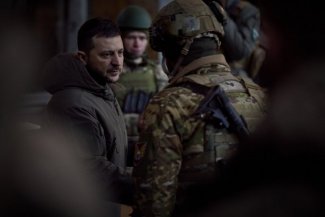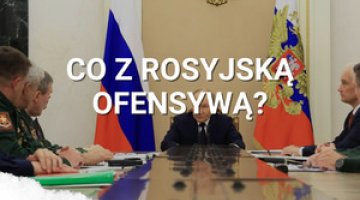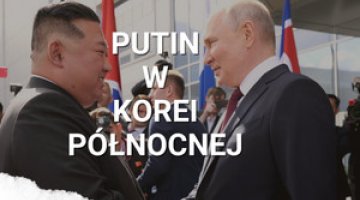Reznikov encourages people to join the Ukrainian Foreign Legion. Day 411 of the war

The main Ukrainian defence line in Bakhmut runs along the railway line separating the centre from the western part of the town. One of the most important points of defence is the Bakhmut-2 train station; the Bakhmut-1 train station, located in the centre, was seized by the Russians last week. Fighting is continuing for Khromove on the western outskirts of Bakhmut, through which supplies for the defenders arrive, and northeast of the junction town of Chasiv Yar. Both sides have been enjoying variable levels of success. Clashes are continuing south of Kreminna, as well as northwest of that town, where Russian forces are trying to reach the line of the Zherebets river (in the Makiivka area). Russian troops have made slight advances north of Avdiivka (between Novobakhmutivka and Novokalynove) and on the northern and southern outskirts of Marinka. The Ukrainian General Staff estimates that Ukrainian troops have repulsed between 50–60 enemy attacks per day.
Russian missile strikes are still mainly targeting the hinterland of the Ukrainian troops in the Donetsk oblast. In recent days, missiles have fallen on Kostiantynivka and Kramatorsk, among other towns. On 9 April, the Russians also launched another missile attack on Zaporizhzhia, as well as on Velykyi Burluk in Kharkiv oblast. A spokesman for the Ukrainian Air Force Command, Colonel Yuri Ihnat, reported that the invaders are using about 20 different types of missiles per day; they are mainly being fired from S-300 systems and aircraft. Russian artillery and aviation are still firing at and bombarding Ukrainian positions along the lines of contact and in border areas. After relative calm in previous weeks, the frequency of hostile shelling in the Chernihiv oblast is rising again. The shelling of Kherson and other towns in the liberated (left-bank) part of the Kherson oblast has also increased periodically in recent days.
On 10 April, deputy defence minister Hanna Malar addressed media reports that the Ukrainian army is preparing a counteroffensive in April or May. She said that officially only three people – President Volodymyr Zelensky, defence minister Oleksiy Reznikov and the Ukrainian Army’s Commander-in-Chief, General Valerii Zaluzhnyi – could speak about the course of the hostilities and the plans of the Armed Forces (AFU) of Ukraine, including any potential counteroffensive. She stressed that modern warfare is first and foremost a war of information, and that all media reports should be considered critically. On 11 April Oleksiy Danilov, Secretary of the National Security and Defence Council, stated that the staff of the Commander-in-Chief of Ukraine’s Armed Forces will decide when to launch the planned counteroffensive at the last minute, and that the higher military-political leadership has several variants prepared. He noted that this is classified information, and only five people (whom he did not name) have access to it.
On 10 April, Minister Reznikov also addressed the issue of the counteroffensive. He noted that time is a decisive factor in the matter of the Ukrainian preparations. He stressed that it is working against the aggressor, who is ready to send up to 3 million people to their deaths, and that the war cannot be “frozen” by any negotiations. He also dismissed criticism from the West of the stubborn defence of Bakhmut, stating that above all it is exhausting the enemy, whose losses are “colossal”.
On 8 April, President Zelensky announced that Ukraine had reached an agreement with Poland to purchase a total of 200 Rosomak wheeled armoured personnel carriers. After his visit to Warsaw the figure of 150 was reported, and earlier the figure was as low as 100. He stated that the first 100 “will be delivered now,” suggesting that the APCs would come from the Polish Army’s own stocks, and another 100 would come “later”. According to Zelensky, Poland has kept all of its promises regarding the delivery of tanks (“especially the Leopards”) which have already reached Ukraine (this includes the transfer of the 60 PT-91/T-72M tanks announced back in the winter). Kyiv and Warsaw have also agreed on the transfer of “over a hundred” infantry fighting vehicles. The previous day, the Polish Armaments Group and Ukroboronprom announced the start of a major overhaul of Ukrainian T-64 tanks at the Bumar-Labędy plant. In the longer term, the plant at Gliwice will also service the T-72 and PT-91 tanks Poland has transferred, and is also being considered as a service centre for the Leopard-2 tanks that Ukraine has received from the Western coalition.
At a joint briefing on 10 April, Reznikov and Denmark’s acting defence minister Troels Lund Poulsen announced that the first 155-mm CAESAR howitzers, from a pool which France originally produced for the Danish army, will most likely arrive in Ukraine “next month”. “By the summer”, in turn, the Ukrainian army should receive the first of the planned 100 Leopard-1 tanks (a large part of which came free after Denmark demobilised them). During the briefing, Reznikov offered work in Ukraine to foreign specialists (who have “the appropriate permits and access to documents”) who would handle the armaments being transferred. He said that this also applies to pilots who can fly F-16 fighters and are ready to take part in the war; “our foreign legion is ready to open its doors”, Reznikov said.
On the same day, Germany revealed details of a new military support package for Ukraine; this included Pionierpanzer-2 Dachs armoured sapper vehicles, 40-mm cartridges, reconnaissance drones, mobile antenna masts and trucks. On 11 April, Bulgaria’s defence ministry confirmed that talks to transfer MiG-29 fighter jets to Kyiv are underway, on condition that the Bulgarian Air Force receives modern Western combat aircraft in return. Sofia has purchased a batch of F-16s from the US, but is not expected to receive them until 2025. The Bulgarian Air Force has 16 MiG-29 fighters in service, although only six of them are operational.
Discussions in the US media on the Ukrainian army’s preparations for a counteroffensive have not sparked much discussion in Ukraine. Ukrainian media reported the leak of information, purportedly from US intelligence institutions, but met with a reserved response from the government in Kyiv. Mykhailo Podolak, an advisor to the head of the President’s Office, called the published materials fake, and said they were the result of a “typical game by Russian special services” aimed at causing a crisis in relations between Western countries and preventing the Ukrainian counteroffensive.
Ukraine’s Security Service has announced more arrests of people suspected of cooperating with Russian intelligence. Among those detained in recent days was a conscript who allegedly passed information to the Russians over the past year about weapons and ammunition stores in Odesa oblast, deliveries of Western equipment, and the staffing of his unit. The SBU also arrested a person who was involved in creating and selling fake social network accounts, which the Russians later used to conduct disinformation campaigns about the situation on the front. In addition, three criminal groups were broken up; they had arranged for men to be exempted from mobilisation or illegally transported abroad for bribes.
On 10 April, Minister Reznikov approved the composition of a 15-member anti-corruption council under the Ukrainian defence ministry. It included representatives of civil society organisations, volunteers and journalists, who were selected through an open online vote accessible to all Ukrainian citizens. The creation of the council is linked to the revelations in January and February this year of several cases of goods being purchased for the army at inflated prices; the scandal triggered a political crisis in Ukraine and came close to removing Reznikov from his position.
Also on 10 April, the Ukrainian parliament passed two laws regarding the exemption from VAT and customs duties on goods destined for the army and other uniformed services entering Ukraine during martial law. In the case of the customs duties, the exemption will apply for an additional three years after martial law is ended.
The same day saw a visit to Minsk by Russian defence minister Sergei Shoigu. During his meeting with Alyaksandr Lukashenka, Shoigu thanked him for providing the Russian army with five military training grounds, as well as for the participation of Belarusian officers as instructors training Russian reservists.
According to Olga Romanova, the chairwoman of the Russia Behind Bars Foundation, the recruitment of criminals in Russian prisons is ongoing. Since February, recruitment has been carried out exclusively by structures subordinate to the defence ministry, and prisoners are being assigned to various units of the Russian army. In recent weeks, cases have been noted of contracts for 18 months being signed, instead of the previous six. According to Romanova, this may be because the Russian command is seriously considering extending the war until 2024.
Authorities in Belgorod and Kursk oblasts have cancelled the traditional 9 May military parades because of the high level of Ukrainian drone activity in these areas near the Russian border: Kursk is 100 kilometres from it, and Belgorod only 30 kilometres.
Commentary
- Minister Reznikov’s declaration to “open the door” to the Ukrainian Foreign Legion is further confirmation of the Ukrainian army’s personnel problems, after the decisions to appoint officers during wartime and start accelerated NCO courses for territorial defence units. Several thousand volunteers, mainly from Western countries, have been fighting on the Ukrainian side since the beginning of the war, but only some of them have professional officer or NCO experience, and as a rule they have taken command positions in international subdivisions. Ukraine first faced a shortage of qualified personnel in the summer and autumn of 2022, after the size of the combined military formations (the Armed Forces, the National Guard and the State Border Service) was increased to 1 million soldiers. In the following months, the problem was compounded by the losses incurred, and in part by the need to withdraw a group of the most experienced and forward-looking military officers from the front to master the Western armaments received from Ukraine’s partners as quickly as possible. Intensifying the process of training cadres on Ukrainian territory and in partner countries has not eliminated the problem; some of the Western-trained soldiers are being sent to serve as training instructors when they return to Ukraine, instead of going to the frontline. Reznikov’s direct reference to F-16 pilots should also be seen as another way of putting pressure on Kyiv’s partners to send such aircraft to Ukraine.
- The emerging statements by Ukrainian government officials on the counteroffensive, suggesting that the reports about it should be met with restraint, can be seen as an attempt to regain control of media coverage in this area. It is noteworthy that the Ukrainian military intelligence service, which in late 2022 and early 2023 introduced the possibility of the spring counteroffensive into the media space as an element of information warfare, has not spoken on the subject recently. The possible impact of the alleged leak of US intelligence data on the operational plans of the Ukrainian Armed Forces, which has been a lively political and media topic in the US in recent days, should be considered negligible. After all, the Ukrainian counteroffensive will be determined not by any public reports about it (regardless of whether they are real or fake), but by the accumulation of the forces and resources necessary to break through Russian defences and ensure success.




